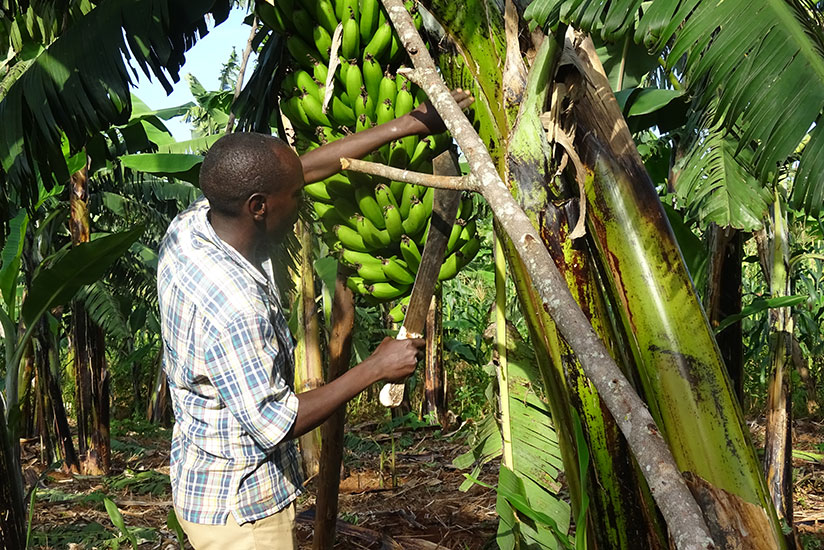For many years, Eugene Rusanganwa used to practise traditional banana farming, resulting in low yields. This, he says, was due to rudimentary practices, lack of modern farming skills, and unavailability of good banana seedlings, among other factors.


For many years, Eugene Rusanganwa used to practise traditional banana farming, resulting in low yields.
This, he says, was due to rudimentary practices, lack of modern farming skills, and unavailability of good banana seedlings, among other factors.
In addition, the resident of Rukara Sector in Kayonza District says the region was experiencing diseases and drought, which denied them good yields.
"I could hardly feed my family and was ranked among the poorest in the village,” says Rusanganywa.
But, two years ago, the father of four, together with other farmers from two sectors in Kayonza, started collaborating to overcome their challenges. They received support from Rwanda Agriculture Board (RAB) in partnership with the Consortium for Improving Agriculture-based Livelihoods in Central Africa (CIALCA), an innovative research-for-development partnership project.
CIALCA operates in Rwanda, Burundi and DR Congo, and is implemented by the International Institute of Tropical Agriculture (IITA) and Bioversity International, with support from the Belgian Development Cooperation (DGD).
Farmers in Kayonza District started multiplying improved varieties known as Injagi, Fhia 17 and Fhia 25. They have also been experimenting with other types such as pisang papan, pelpita and apantu.
Local macro-propagation technology was introduced to allow farmers to multiply their own disease-free banana planting materials in large quantities. Currently, there are four macro-propagations in both Nyamirama and Rukara sectors.
Rusanganwa expects his second harvest this year.
"I am expecting to start harvesting from June through October, and I am optimistic this will earn me between Rwf300,000 and Rwf400,000 each month,” he says.
Farmers are expecting to get over 8,000 new plantlets multiplied from the four macro propagators that will be distributed to other farmers in the district.
Achievements
Rusanganwa says, unlike in the past, he can now afford Mutuelles de Santé (a health insurance scheme), educate his children as well as provide for his family.
"I have managed to buy a cow and five goats. I am also planning to expand my banana growing project in the future,” he says, adding that he hopes to build a modern house and educate his children up to university level.
Alice Kabanyana, another farmer from Nyamirama Sector, says her family is now leading a better life thanks to the project. She grows FHIA15, FHIA25 and other banana varieties alongside complementary CIALCA-supported activities such as training on how to improve their nutrition and health.
"Our lives have changed since we started working with the CIALCA project and the Rwanda Agriculture Board. I am getting good yields from my small piece of land where I grow improved banana,” says the mother of three.
"We are multiplying more seedlings which we will use to expand the banana plantation. I am grateful that I can have enough produce and feed my family. I am optimistic that, in the near future, I will be able to even take the surplus produce to the market,” she adds.
Building on 10 years of investment and partnership, CIALCA is trying to improve food, income and nutrition security in Central Africa, while preserving land for future generations.
According to Dr Marc Schut, CIALCA coordinator, the project works hand in hand with both public and private institutions to ensure that research findings and new technologies work for farmers and other clients.
"We work closely with governments, development organisations and the private sector. By doing research together, we ensure that we develop innovations that are useful, and that – through our partners – we can reach thousands of farmers,” he said.
More efforts put in
Information from Rwanda Agriculture Board shows that despite rehabilitation, more work has to be done. According to Dr Svetlana Gaidashova , the National Banana Research programme leader at RAB, only 30 per cent of the total area under banana production is using modern farming practices.
"This remains a challenge, especially in areas where fewer resources are available. The Rwandan government, has promoted commercial farming by supplying large quantities of banana planting materials.
"This effort is driven by private sector,” she said. RAB is planning to scale up banana seed production to make best banana varieties accessible in the whole of Rwanda,’’ she added.
editorial@newtimes.co.rw


